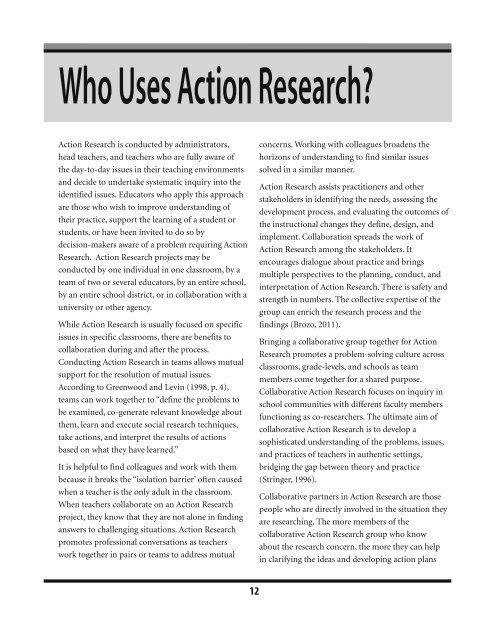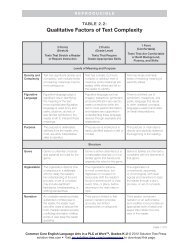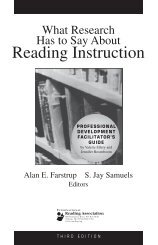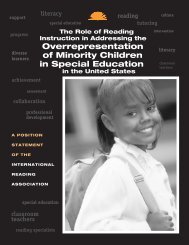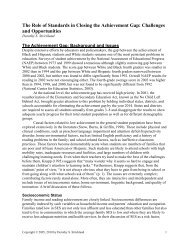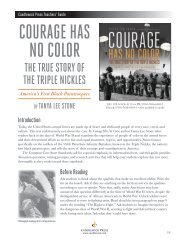A Practical Guide to Action Research for Literacy Educators
A Practical Guide to Action Research for Literacy Educators
A Practical Guide to Action Research for Literacy Educators
You also want an ePaper? Increase the reach of your titles
YUMPU automatically turns print PDFs into web optimized ePapers that Google loves.
Who Uses <strong>Action</strong> <strong>Research</strong>?<br />
<strong>Action</strong> <strong>Research</strong> is conducted by administra<strong>to</strong>rs,<br />
head teachers, and teachers who are fully aware of<br />
the day-<strong>to</strong>-day issues in their teaching environments<br />
and decide <strong>to</strong> undertake systematic inquiry in<strong>to</strong> the<br />
identified issues. Educa<strong>to</strong>rs who apply this approach<br />
are those who wish <strong>to</strong> improve understanding of<br />
their practice, support the learning of a student or<br />
students, or have been invited <strong>to</strong> do so by<br />
decision-makers aware of a problem requiring <strong>Action</strong><br />
<strong>Research</strong>. <strong>Action</strong> <strong>Research</strong> projects may be<br />
conducted by one individual in one classroom, by a<br />
team of two or several educa<strong>to</strong>rs, by an entire school,<br />
by an entire school district, or in collaboration with a<br />
university or other agency.<br />
While <strong>Action</strong> <strong>Research</strong> is usually focused on specific<br />
issues in specific classrooms, there are benefits <strong>to</strong><br />
collaboration during and after the process.<br />
Conducting <strong>Action</strong> <strong>Research</strong> in teams allows mutual<br />
support <strong>for</strong> the resolution of mutual issues.<br />
According <strong>to</strong> Greenwood and Levin (1998, p. 4),<br />
teams can work <strong>to</strong>gether <strong>to</strong> “define the problems <strong>to</strong><br />
be examined, co-generate relevant knowledge about<br />
them, learn and execute social research techniques,<br />
take actions, and interpret the results of actions<br />
based on what they have learned.”<br />
It is helpful <strong>to</strong> find colleagues and work with them<br />
because it breaks the “isolation barrier’ often caused<br />
when a teacher is the only adult in the classroom.<br />
When teachers collaborate on an <strong>Action</strong> <strong>Research</strong><br />
project, they know that they are not alone in finding<br />
answers <strong>to</strong> challenging situations. <strong>Action</strong> <strong>Research</strong><br />
promotes professional conversations as teachers<br />
work <strong>to</strong>gether in pairs or teams <strong>to</strong> address mutual<br />
concerns. Working with colleagues broadens the<br />
horizons of understanding <strong>to</strong> find similar issues<br />
solved in a similar manner.<br />
<strong>Action</strong> <strong>Research</strong> assists practitioners and other<br />
stakeholders in identifying the needs, assessing the<br />
development process, and evaluating the outcomes of<br />
the instructional changes they define, design, and<br />
implement. Collaboration spreads the work of<br />
<strong>Action</strong> <strong>Research</strong> among the stakeholders. It<br />
encourages dialogue about practice and brings<br />
multiple perspectives <strong>to</strong> the planning, conduct, and<br />
interpretation of <strong>Action</strong> <strong>Research</strong>. There is safety and<br />
strength in numbers. The collective expertise of the<br />
group can enrich the research process and the<br />
findings (Brozo, 2011).<br />
Bringing a collaborative group <strong>to</strong>gether <strong>for</strong> <strong>Action</strong><br />
<strong>Research</strong> promotes a problem-solving culture across<br />
classrooms, grade-levels, and schools as team<br />
members come <strong>to</strong>gether <strong>for</strong> a shared purpose.<br />
Collaborative <strong>Action</strong> <strong>Research</strong> focuses on inquiry in<br />
school communities with different faculty members<br />
functioning as co-researchers. The ultimate aim of<br />
collaborative <strong>Action</strong> <strong>Research</strong> is <strong>to</strong> develop a<br />
sophisticated understanding of the problems, issues,<br />
and practices of teachers in authentic settings,<br />
bridging the gap between theory and practice<br />
(Stringer, 1996).<br />
Collaborative partners in <strong>Action</strong> <strong>Research</strong> are those<br />
people who are directly involved in the situation they<br />
are researching. The more members of the<br />
collaborative <strong>Action</strong> <strong>Research</strong> group who know<br />
about the research concern, the more they can help<br />
in clarifying the ideas and developing action plans<br />
12


